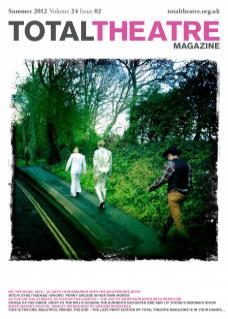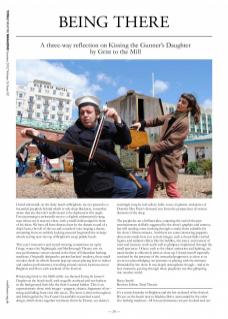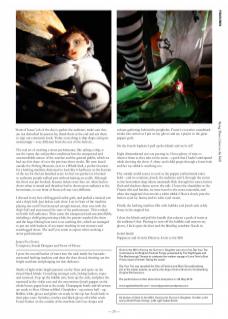I bend awkwardly on the shaly beach at Brighton, my eye pressed to a barnacled peephole behind which is only deep blackness, somewhat aware that my skirt isn’t really meant to be deployed at this angle. I’m scrumming in awkwardly next to a slightly embarrassed young man whose ear is near my chest, with a small child wedged in front of his shins. We have all been drawn closer by the distant sound of a ship’s horn, the roll of the sea and a cracked voice singing a shanty, emanating from an unlikely looking seaweed-begrimed hut on large wheels resting near the top of Brighton’s steep pebbly beach.
This year’s innovative and award-winning commission set up by Fringe venues the Nightingale and Marlborough Theatre saw six new performance venues created in the form of Edwardian bathing machines. Originally designed to protect bathers’ modesty, these small wooden sheds on wheels became pop-up venues playing host to indoor and outdoor performances, travelling around various locations across Brighton and Hove each weekend of the Festival.
Witnessing Grist to the Mill’s richly sea-themed Kissing the Gunner’s Daughter on the beach itself, with seagulls overhead and sun-bathers in the background, feels like the show’s natural habitat. This is an expressionistic show, with images – puppets, objects, fragments of set – rising and falling from view like waves. The show is driven throughout and held together by Foz Foster’s beautifully researched sound design, which draws together testimony from the Titanic, sea shanty’s seemingly sung by real sailors, bells, waves, foghorns, and pieces of Dorothy Max Prior’s dramatic text from the perspectives of various denizens of the deep.
The peepholes are a brilliant idea, conjuring the end-of-the-pier entertainments skilfully suggested by the show’s graphics and context, but still needing some working through to make them tolerable for the show’s fifteen minutes. And there are some interesting puppetry discoveries made here too: certain images, such as beautifully crafted figures and ambient effects like the bubbles, the water, and corners of mast and treasure, work really well as glimpses, heightened through the small apertures. Others, such as the object animation and lighting, are much harder to effectively achieve close-up. I found myself especially confused by the presence of the unmasked puppeteer, so close to us yet never acknowledging our presence or playing with the intimacy demanded by her show. It was deeply atmospheric though – and at its best moments, peering through those peepholes was like glimpsing into another world.
Beccy Smith Reviews Editor, Total Theatre
It’s a sunny Saturday in Brighton and the last weekend of the festival. We are on the beach next to Madeira Drive surrounded by the other five bathing machines. All four performances are pre-booked and our ‘front of house’ job of the day is: gather the audience; make sure they are not disturbed by passers by; thank them at the end and ask them to sign our comments book. Today everything is ship shape and goes swimmingly – very different from the rest of the festival...
The real art of working a street performance, like sailing a ship, is not the sunny day and perfect conditions but the unexpected and uncontrollable nature of the weather and the general public, which we had our fair share of over the previous three weeks. We were based outside the Fishing Museum, next to a Whelk Stall, a perfect location for a bathing machine distressed to look like it had been on the bottom of the sea for the last hundred years. In fact too perfect as it looked so authentic people walked past without batting an eyelid. Although the show was pre-booked, because tickets were free, we often had no-shows when it rained and therefore had to drum up an audience at the last minute, so our front of house job was very different.
I dressed in my best old haggered sailor garb, and packed a musical saw and a ship’s bell. Just before each show I sat in front of the machine playing saw until I had attracted enough interest, then rose with the ship’s bell and announced the start of the performance. This worked well with full audiences. Then came the unexpected and uncontrollable, including a child going missing while the parents watched the show and the large fishing boat next to us catching fire, which we managed to put out with buckets of sea-water resulting in wet trousers and waterlogged shoes. The stuff you come to expect when working a street performance!
James Foz Foster Composer, Sound Designer and Front-of-House
I pour the second bucket of water into the tank inside the barnacle-encrusted bathing machine and slam the door closed, shutting out the bright sunshine and plunging me into darkness.
Shafts of light make bright patterns on the floor and spots on the closed black blinds. Crouching amongst sails, fishing baskets, ropes and seaweed, I top up the bubble mix, hoist up the sails, and place the mermaid in the violin case and the unconscious Jonah puppet on the whale bones, paper boat at the ready. Champagne bottle and silverware are ready to float. Glitter refilled. Chandelier – up; mirror ball – up. Rabbit, white gloves and glitter are ready in the top hat. Souls back in their pipe cases. Switches, torches and black gloves all within reach. Foster bashes on the outside of the machine and I see shapes and colours gathering behind the peepholes. Foster’s evocative soundtrack creaks into action as I put on my gloves and say a prayer to the great puppet gods.
On the fourth foghorn I pull up the blinds and we’re off!
Eight dismembered eyes are peering in. I have plenty of time to observe them as they take in the scene – a perk that I hadn’t anticipated while devising the show. A shiny-eyed child peeps through a lower hole and her toy rabbit is watching too.
The outside world ceases to exist as the puppet enchantment takes hold – and we continue, Jonah, the audience and I, through the storm to the bottomless deep where mermaids flick through the water, knives flash and shadows dance across the sails. I lower the chandelier as the Titanic tilts and lurches, we time travel to the costa concordia, and when the magician’s hat reveals a white rabbit I float it slowly past the button-eyed toy bunny and its wide-eyed owner.
Finally the bathing machine fills with bubbles and Jonah sails safely home in the magical hat.
I close the blinds and pull the handle that releases a gush of water at the audience’s feet. Pausing to turn off the bubbles and remove my gloves, I kick open the door and the blinding sunshine floods in.
Isobel Smith Puppeteer and Artistic Director, Grist to the Mill
Grist to the Mill’s Kissing the Gunner’s Daughter was one of six Dip Your Toe commissions for Brighton Festival Fringe, presented by The Nightingale and The Marlborough Theatre to celebrate the maiden voyage of Lone Twin’s Boat Project (part of Artists Taking the Lead).
Dip Your Toe was awarded the Star of Festival and Most Groundbreaking Act at the Latest awards, as well as the Argus Critics Choice for Outstanding Original Performance.
The performance written about here took place on 26 May 2012.


